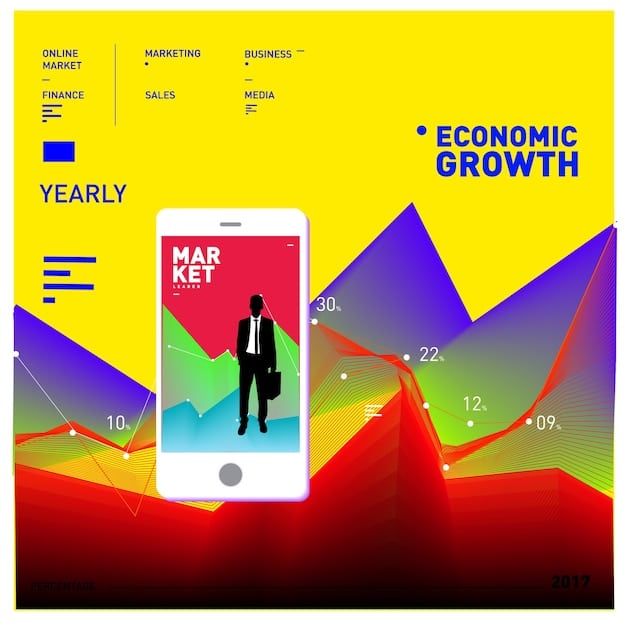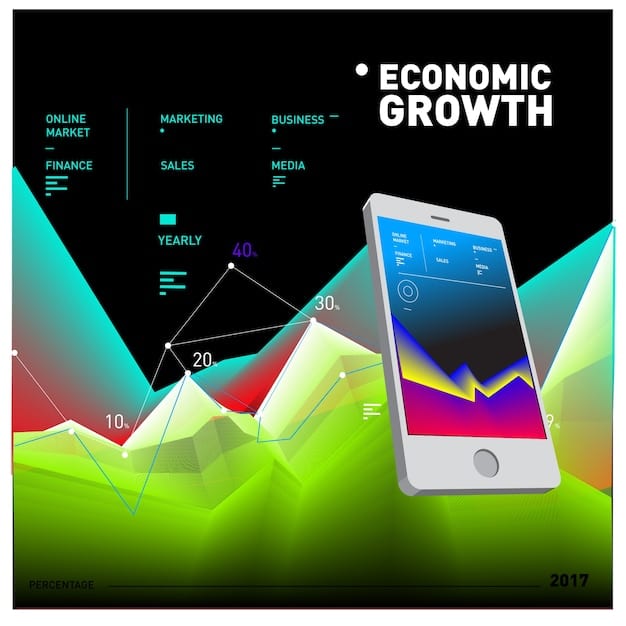E-commerce Market Trends: Capitalizing on the Online Rise

E-commerce market trends reveal significant growth, presenting businesses with lucrative opportunities to expand their online presence and cater to evolving consumer behaviors through strategic implementations and adaptations.
The market trends: the rise of e-commerce isn’t just a shift; it’s a revolution reshaping how businesses operate and consumers shop. For businesses in the US, understanding and capitalizing on these trends is no longer optional—it’s essential for survival and growth.
Navigating the E-commerce Landscape: Key Trends to Watch
The e-commerce landscape is constantly evolving, driven by technological advancements and changing consumer preferences. Businesses need to stay informed about the key trends to adapt their strategies and remain competitive. This section explores the critical shifts shaping the market.
Mobile Commerce Dominance
Mobile commerce, or m-commerce, continues to grow as consumers increasingly use smartphones and tablets for online shopping. Optimizing the mobile shopping experience is crucial for businesses to reach a wider audience and drive sales.
Personalization and Customer Experience
Personalization is key to enhancing the customer experience and building brand loyalty. By leveraging data and analytics, businesses can tailor offers, product recommendations, and marketing messages to individual customer preferences.
- 📈 Utilize AI-powered personalization tools to analyze customer behavior and preferences.
- 🤝 Offer personalized product recommendations based on past purchases and browsing history.
- 📧 Create segmented email campaigns with tailored content for different customer groups.
The e-commerce market’s expansion calls for a more intimate and intuitive shopping experience. As technology evolves, so do consumer expectations. Businesses must go beyond simple transactions and create personalized interactions that resonate with each customer’s unique needs and desires. By focusing on building lasting relationships through tailored experiences, brands can ensure loyalty and advocacy in a competitive digital landscape.

Artificial Intelligence and Automation in E-commerce
Artificial intelligence (AI) and automation technologies are revolutionizing e-commerce, enabling businesses to streamline operations, improve customer service, and enhance the overall shopping experience. This section delves into how AI and automation are being implemented across various areas of e-commerce.
Chatbots and Virtual Assistants
Chatbots and virtual assistants provide instant customer support, answer frequently asked questions, and guide shoppers through the purchasing process. These AI-powered tools enhance customer satisfaction and free up human agents to handle more complex inquiries.
Predictive Analytics for Inventory Management
Predictive analytics uses historical data and machine learning algorithms to forecast demand and optimize inventory levels. This helps businesses minimize stockouts, reduce excess inventory, and improve supply chain efficiency.
- 🤖 Implement chatbots on your website and social media channels to provide 24/7 customer support.
- 🛒 Use predictive analytics to forecast demand and optimize inventory levels.
- 🚚 Automate order fulfillment processes to reduce shipping times and improve accuracy.
AI-driven solutions are transforming e-commerce by empowering businesses to make smarter decisions, automate routine tasks, and deliver exceptional customer experiences. Embracing these technologies is no longer a luxury but a necessity for staying competitive and relevant in today’s dynamic online marketplace. From personalized recommendations to streamlined logistics, AI is reshaping the future of e-commerce, promising greater efficiency, profitability, and customer satisfaction.
The Role of Social Commerce in Driving E-commerce Growth
Social commerce, the practice of selling products and services directly on social media platforms, is becoming increasingly popular as consumers spend more time online. This section will discuss how businesses can leverage social commerce to drive e-commerce growth.
Integrating Shopping Features on Social Media
Social media platforms like Instagram, Facebook, and Pinterest offer integrated shopping features that allow users to purchase products directly from their feeds. This seamless shopping experience can significantly boost sales and engagement.
Influencer Marketing Strategies
Influencer marketing involves partnering with social media influencers to promote products and brands to their followers. This strategy can be highly effective in reaching new customers and building brand awareness.

- 📱 Integrate shopping features on your social media profiles to enable direct purchases.
- 🌟 Partner with influencers to promote your products and reach new audiences.
- 📣 Run targeted social media ad campaigns to drive traffic to your online store.
Social commerce has emerged as a powerful force in the e-commerce landscape, redefining how consumers discover, interact with, and purchase products online. By seamlessly integrating shopping features into social media platforms, businesses can tap into vast networks of potential customers and create more engaging and personalized shopping experiences. As social media continues to evolve, brands that embrace social commerce will be well-positioned to thrive in an increasingly competitive digital marketplace, building stronger connections with their audience and driving sustainable growth.
Sustainability and Ethical Practices in E-commerce
Consumers are increasingly concerned about sustainability and ethical practices, and they expect businesses to align with their values. This section explores how e-commerce businesses can adopt sustainable practices to attract and retain customers.
Eco-Friendly Packaging and Shipping
Using sustainable packaging materials and reducing shipping waste can help businesses minimize their environmental impact and appeal to eco-conscious consumers. Consider using recycled materials, minimizing packaging size, and offering carbon-neutral shipping options.
Transparency and Ethical Sourcing
Being transparent about your supply chain and ensuring ethical sourcing of materials can build trust with customers and enhance your brand reputation. Provide detailed information about your products and their origins, and prioritize working with suppliers who adhere to fair labor practices.
As consumer awareness grows regarding the environmental and social impacts of their purchasing decisions, sustainability has become a critical factor influencing buying behavior. By adopting eco-friendly practices and promoting ethical sourcing, e-commerce businesses can not only reduce their carbon footprint but also enhance their brand image and build stronger connections with conscious consumers. Transparency is key, and brands that openly communicate their sustainability efforts are more likely to attract and retain environmentally and socially responsible customers.
Data Privacy and Security in E-commerce
Protecting customer data is paramount in e-commerce, as data breaches can damage your reputation and erode customer trust. This section emphasizes the importance of implementing robust data privacy and security measures.
Complying with Data Protection Regulations
Ensure compliance with data protection regulations such as GDPR and CCPA to protect customer data and avoid legal penalties. Implement strong data encryption, privacy policies, and data breach response plans.”
Building Customer Trust through Transparency
Being transparent about how you collect, use, and protect customer data can build trust and encourage customers to share their information. Provide clear and concise privacy policies, and obtain explicit consent before collecting data.
- 🔒 Implement robust data encryption to protect customer information.
- 📜 Ensure compliance with data protection regulations such as GDPR and CCPA.
- 🛡️ Develop a data breach response plan to mitigate potential risks.
In an era where data breaches and privacy concerns are rampant, safeguarding customer information is not only a legal imperative but also a moral one. By prioritizing data protection and transparency, e-commerce businesses can build stronger relationships with their customers, fostering trust and loyalty. Implementing robust security measures, complying with privacy regulations, and communicating transparently about data practices are essential steps for creating a safe and secure online shopping environment.
Future Trends and Innovations in E-commerce
The e-commerce landscape is constantly evolving, and businesses need to stay ahead of the curve to remain competitive. This section explores some of the emerging trends and innovations that are poised to shape the future of e-commerce.
Augmented Reality (AR) and Virtual Reality (VR) Shopping Experiences
AR and VR technologies offer immersive shopping experiences that allow customers to visualize products in their own environment before making a purchase. This can enhance customer engagement, reduce returns, and drive sales. E-commerce businesses can integrate AR features into their mobile apps or websites to enable customers to try on clothes virtually, preview furniture in their homes, and explore other products in a more interactive way.
Voice Commerce and Smart Assistants
With the increasing popularity of voice assistants like Amazon Alexa and Google Assistant, voice commerce is becoming more prevalent. Optimizing your e-commerce store for voice search and enabling voice-based purchases can help you reach a new audience and drive sales.
- 👓 Explore AR and VR technologies to create immersive shopping experiences.
- 🗣️ Optimize your e-commerce store for voice search and enable voice-based purchases.
- 🚀 Embrace new payment methods such as cryptocurrencies and blockchain technology.
As technology continues to advance at an unprecedented pace, the future of e-commerce is teeming with exciting possibilities. From immersive augmented reality experiences to frictionless voice commerce, businesses that embrace innovation and adapt to emerging trends will be best positioned to thrive in the ever-evolving digital landscape. By exploring new technologies and reimagining the customer journey, e-commerce businesses can unlock new opportunities for growth, engagement, and customer satisfaction.
| Key Point | Brief Description |
|---|---|
| 📱 Mobile Dominance | Optimize mobile shopping experiences for growth. |
| 🤖 AI and Automation | Leverage AI for support and inventory management. |
| 📣 Social Commerce | Integrate shopping on social platforms for sales. |
| 🔒 Data Security | Protect data and build transparency with customers. |
Frequently Asked Questions (FAQs)
▼
E-commerce is experiencing substantial growth, driven by increased online shopping and technological advancements. This trend is expected to continue as more consumers embrace digital channels.
▼
Businesses can optimize their e-commerce strategy by focusing on mobile optimization, personalization, AI integration, social commerce, data security, and sustainable practices to attract and retain customers.
▼
AI enhances e-commerce experiences through chatbots, predictive analytics, and personalized recommendations, improving customer service and streamlining operations for better efficiency and customer satisfaction.
▼
Sustainability is crucial because consumers are increasingly concerned about environmental impacts. Businesses adopting eco-friendly practices and ethical sourcing can attract and build strong, lasting relationships.
▼
Businesses can ensure data privacy by complying with regulations like GDPR and CCPA, implementing data encryption, having clear privacy policies, and maintaining transparency to build and maintain customer trust.
Conclusion
In conclusion, the rise of e-commerce presents vast opportunities for businesses willing to adapt and innovate. By staying informed about the key trends, embracing new technologies, and prioritizing customer experience, businesses can capitalize on the evolving online market and achieve sustainable growth.





